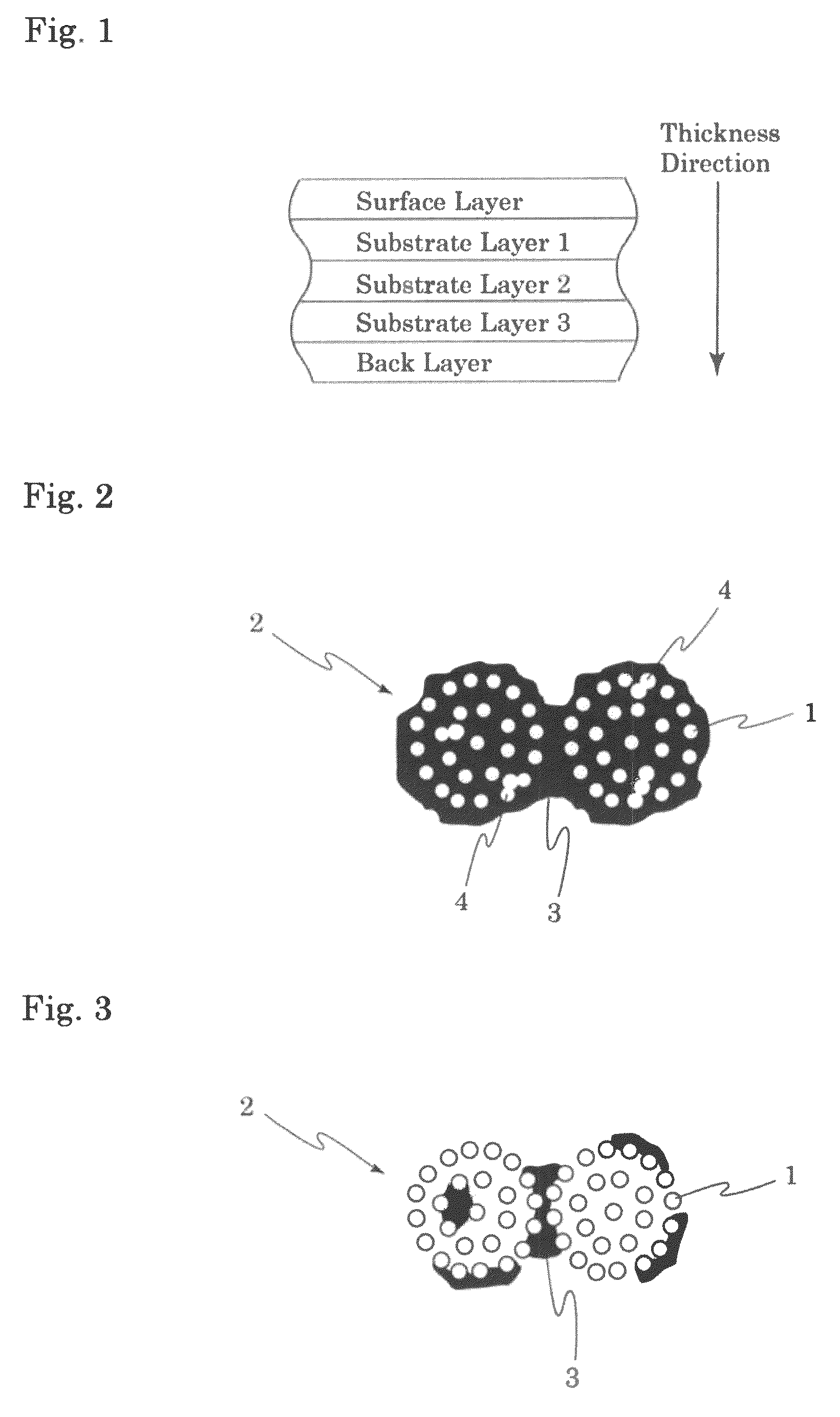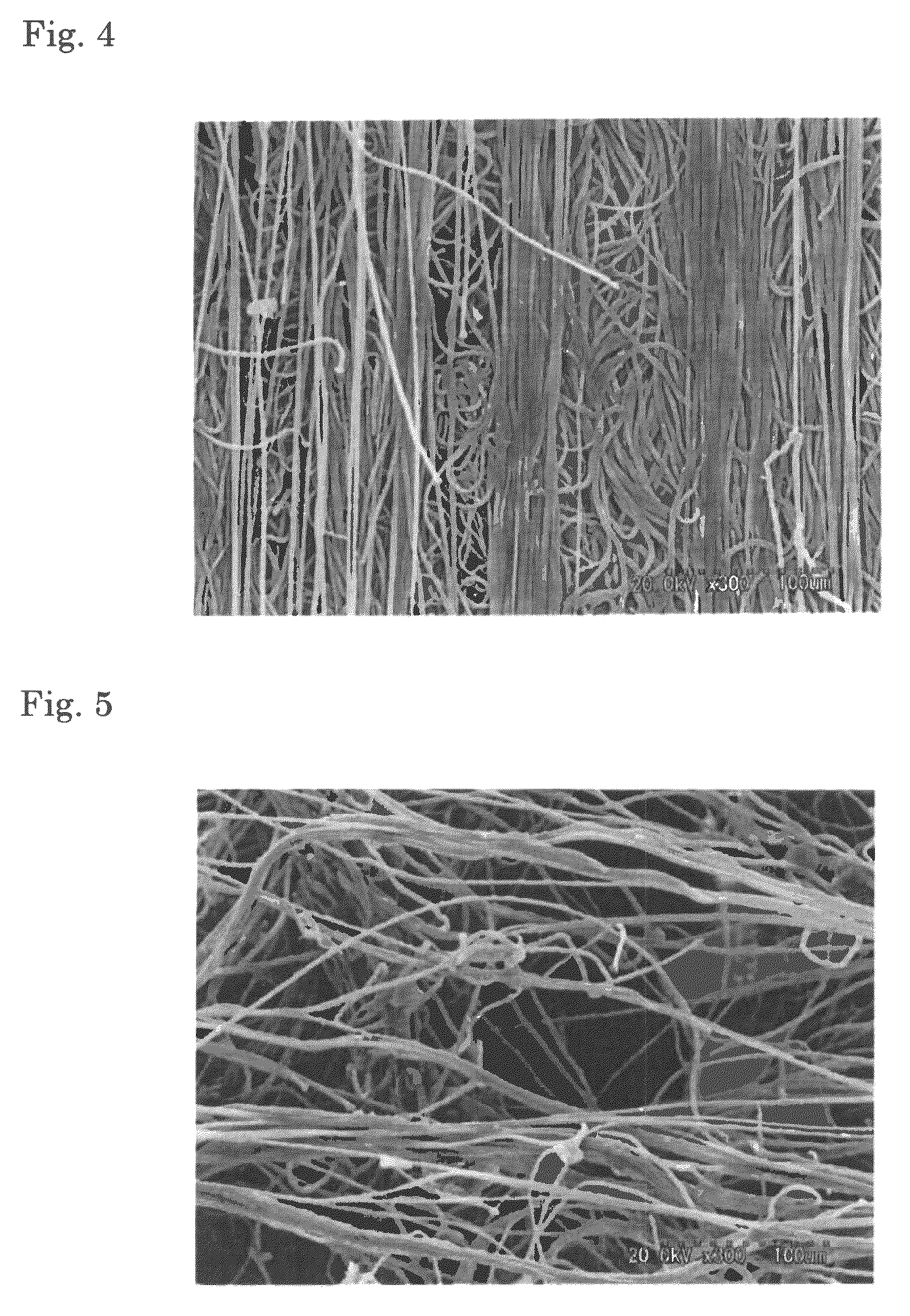Leather-like sheet bearing grain finish and process for producing the same
a leather-like sheet and grain finish technology, applied in the field of grain-finished leather-like sheets, can solve the problems of leather-like sheets, inadequate practical strength, and rubbery compression resistan
- Summary
- Abstract
- Description
- Claims
- Application Information
AI Technical Summary
Benefits of technology
Problems solved by technology
Method used
Image
Examples
production example 1
Production of Water-soluble, Thermoplastic Polyvinyl Alcohol Resin
[0265]A 100-L pressure reactor equipped with a stirrer, a nitrogen inlet, an ethylene inlet and an initiator inlet was charged with 29.0 kg of vinyl acetate and 31.0 kg of methanol. After raising the temperature to 60° C., the reaction system was purged with nitrogen by bubbling nitrogen for 30 min. Then, ethylene was introduced so as to adjust the pressure of the reactor to 5.9 kgf / cm2. A 2.8 g / L methanol solution of 2,2′-azobis(4-methoxy-2,4-dimethylvaleronitrile) (initiator) was purged with nitrogen by nitrogen gas bubbling. After adjusting the temperature of reactor to 60° C., 170 mL of the initiator solution was added to initiate the polymerization. During the polymerization, the pressure of reactor was maintained at 5.9 kgf / cm2 by introducing ethylene, the polymerization temperature was maintained at 60° C., and the initiator solution was continuously added at a rate of 610 mL / h. When the conversion of polymeriz...
example 1
[0268]The modified PVA (water-soluble, thermoplastic polyvinyl alcohol resin: sea component) and isophthalic acid-modified polyethylene terephthalate having a modification degree of 6 mol % (island component) were extruded from a spinneret for melt composite spinning (number of island: 25 / fiber) at 260° C. in a sea component / island component ratio of 25 / 75 (by mass). The ejector pressure was adjusted such that the spinning speed was 3700 m / min, and partially oriented sea-island long fibers having an average fineness of 2.0 dtex were collected on a net, to obtain a long fiber web having a mass per unit area of 30 g / m2.
[0269]After providing an oil agent, the long fiber web was cross-lapped into 18 layers to prepare a superposed web having a total mass per unit area of 540 g / m2 which was then sprayed with an oil agent for preventing needle break. The superposed web was needle-punched in a density of 2400 punch / cm2 alternatively from both sides using 6-barb needles with a distance of 3....
example 2
[0274]A grain-finished leather-like sheet was produced in the same manner as in Example 1 except for hot-pressing one surface of the elastic polymer-containing leather-like sheet by a metal roll at 172° C. (the opposite surface was in contact with a non-heated rubber roll) to fuse-bond only the fibers in the surface layer which exhibited an endothermic subpeak at 148° C. As in Example 1, the obtained grain-finished leather-like sheet had a low compression resistance, a dense feel and a softness each resembling those of natural leathers.
PUM
| Property | Measurement | Unit |
|---|---|---|
| temperature | aaaaa | aaaaa |
| temperature | aaaaa | aaaaa |
| elongation | aaaaa | aaaaa |
Abstract
Description
Claims
Application Information
 Login to View More
Login to View More - R&D
- Intellectual Property
- Life Sciences
- Materials
- Tech Scout
- Unparalleled Data Quality
- Higher Quality Content
- 60% Fewer Hallucinations
Browse by: Latest US Patents, China's latest patents, Technical Efficacy Thesaurus, Application Domain, Technology Topic, Popular Technical Reports.
© 2025 PatSnap. All rights reserved.Legal|Privacy policy|Modern Slavery Act Transparency Statement|Sitemap|About US| Contact US: help@patsnap.com



